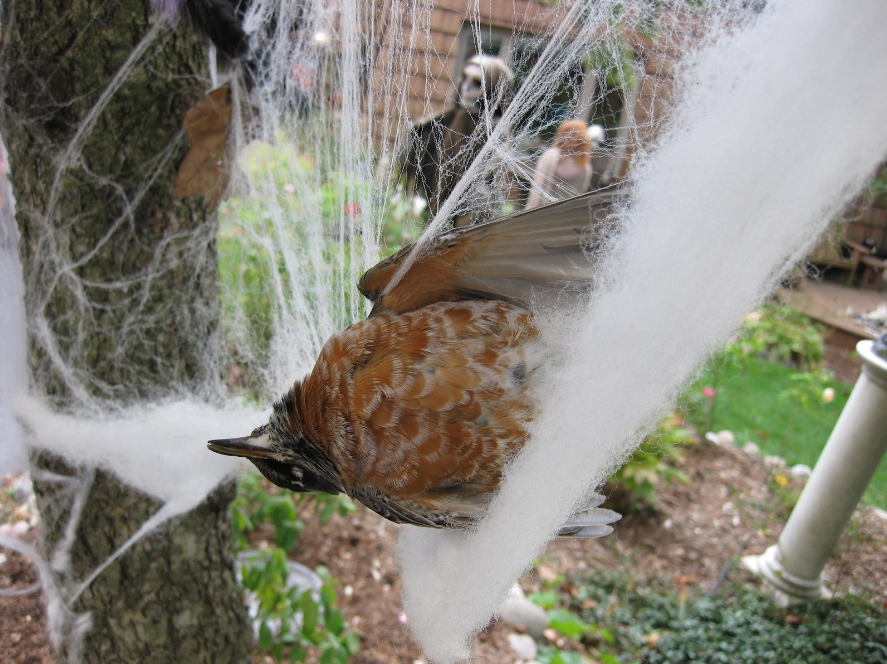American Robin caught in fake spider webs. Source: https://www.chicagobirder.org/blog/2023/10/14/holiday-decor-danger
Synthetic spider webs have long been a staple of Halloween decorations worldwide; however, they pose a lesser-known threat to small animals. In recent years, there has been a significant increase in reports in the US of animals—mostly small birds such as hummingbirds and owls—getting tangled in the decorative webbing (Izzo). This risk of entanglement is due to the strength of the thin fiber-like polyester strands, which trap birds and lead to injuries, starvation, or even death. Furthermore, birds may use pieces of these fake spider webs to build their nests, potentially trapping any chicks in the nest. Other animals may also become stuck in these webs, such as lizards, hedgehogs, and toads (Achenza). It is also important to note that these webs are non-biodegradable, meaning that they do not break down naturally over time.
Decorative spider webs. Source: https://i.pinimg.com/originals/05/57/ca/0557ca98b484dbb554e1b77ce9a85d15.jpg
At ASB, similar concerns have been raised over the use of synthetic spider webs during our Halloween festivities. In past years, these cheap and popular decorations have seen use all throughout the school. Since our school’s EcoCommittee’s theme this year is biodiversity, more importance has been placed on taking care of local wildlife. As a result, more durable and reusable decorations have been bought by the Parent Association to minimize harm to local animals. Fake spider webs are also no longer used around the school.
According to Halía—one of the high-school student coordinators of elementary school’s Eco Club—the elementary schoolers who participate in trash pickups still find pieces of synthetic spiderwebs around our school’s campus.
During Halloween season, global usage of synthetic spider webs is a problem that poses a serious threat to local wildlife. As such, it is important to spread awareness and take measures to reduce the risk to animals. Of course, prevention is the most effective countermeasure: refraining from using fake spider webs is the best course of action for animals and the environment. Following this, quickly and responsibly disposing of synthetic webs once festivities are over reduces the risk of an animal being trapped. Consider moving webs indoors or creating webbing out of rope to minimize risks to wildlife. When asked about the possible impacts to local wildlife, Rafael from 12th grade stated that he feels worried, and that “it would be an easy fix” to stop using such decorations, mitigating the risk of harm to the animals.
Luckily, since Halloween is a seasonal event, synthetic webs are only a threat to animals for a few weeks out of the whole year while they are hung up, making them a relatively uncommon problem. Due to the plastic pollution they cause, however, their harms persist over the course of the year. As a result, it is still important to do your own part in lessening their use and let others know of the potential risks that spiderwebs pose.
Bibliography:
Achenza, Madeleine. “Synthetic Spider Webs Pose Dangerous Threat to Local Wildlife This Halloween.” New York Post, New York Post, 21 Oct. 2023, nypost.com/2023/10/21/synthetic-spider-webs-pose-dangerous-threat-to-local-wildlife-this-halloween/.
Izzo, Jack. “Does Decorative Spider Webbing Pose a Danger to Wildlife?” Snopes, Snopes.com, 20 Oct. 2023, www.snopes.com/news/2023/10/20/decorative-spider-webs-dangerous-or-no/.

